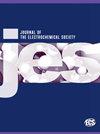Synergistic Effect of Vanadate and Nanoclay Hybrid Inhibitor on the Self-Corrosion and Discharge Activity of Al Anode in Alkaline Aluminum-Air Batteries
IF 3.1
4区 工程技术
Q2 ELECTROCHEMISTRY
引用次数: 2
Abstract
The inherent safety and low cost of aqueous aluminum-air (Al-air) batteries have attracted significant attention. However, their lifespan is constrained due to the formation of passive layers and severe self-corrosion of the Al anode. This work addresses the Al anode issues using an innovative design strategy by adding vanadate and nanoclay to modify the interaction of Al and electrolyte. The results have shown that adding each vanadate, nanoclay, and a hybrid combination of both reduced Al anode corrosion considerably. However, the hybrid additive provided the highest inhibition efficiency of 72.6% compared to 57.6% for vanadium and 69.8% for nanoclay. The anode's anodic efficiency and capacity density reached 81.4% and 2426 mAh.g-1 using a hybrid inhibitor. Electrochemical and microscopical analysis indicated that the corrosion inhibition of the additives was attributed to a protective film formed on the Al anode surface. Therefore, this technique has the potential for application in Al-air batteries to increase their lifespan by increasing the inhibition efficiency of the Al anode.钒酸盐和纳米粘土复合缓蚀剂对碱性铝-空气电池铝阳极自腐蚀和放电活性的协同作用
铝-空气(Al-air)水电池的固有安全性和低成本引起了人们的广泛关注。然而,由于钝化层的形成和铝阳极严重的自腐蚀,它们的使用寿命受到限制。本研究采用一种创新的设计策略,通过添加钒酸盐和纳米粘土来改变铝和电解质的相互作用,解决了铝阳极的问题。结果表明,添加钒酸盐、纳米粘土以及两者的混合组合均可显著降低铝阳极的腐蚀。然而,杂化添加剂的抑制效率最高,为72.6%,而钒和纳米粘土的抑制效率分别为57.6%和69.8%。阳极效率达到81.4%,容量密度达到2426 mAh。G-1使用混合抑制剂。电化学和微观分析表明,添加剂的缓蚀作用是由于在铝阳极表面形成保护膜。因此,该技术具有应用于铝空气电池的潜力,可以通过提高铝阳极的抑制效率来延长电池寿命。
本文章由计算机程序翻译,如有差异,请以英文原文为准。
求助全文
约1分钟内获得全文
求助全文
来源期刊
CiteScore
7.20
自引率
12.80%
发文量
1369
审稿时长
1.5 months
期刊介绍:
The Journal of The Electrochemical Society (JES) is the leader in the field of solid-state and electrochemical science and technology. This peer-reviewed journal publishes an average of 450 pages of 70 articles each month. Articles are posted online, with a monthly paper edition following electronic publication. The ECS membership benefits package includes access to the electronic edition of this journal.

 求助内容:
求助内容: 应助结果提醒方式:
应助结果提醒方式:


